The Ottoman architect Mimar Sinan or Sinan al-Din Yusuf bin Abd al-Manan, born on May 28, 1489, in the Turkish city of Kayseri, in the arms of an Armenian Orthodox famil.
After reaching the age of majority, his family sent him in 1511 during the reign of Sultan Yavuz Selim to Istanbul Duchirmi, where he grew up in the arms of the palace and received the sciences Religious and secular in him and he became one of the most famous Architects and creative painters in the palace.
These children were responsible in all stages of their lives from the palace, as the palace provided them with shelter, decent living, marriage and everything they needed, and the Duchiremans served in the army during the march of the conquests, and after their return from the conquests, they worked and excelled in the field that they learned during their stay in the palace.
Sinan also joined the Balkan conquests in 1538, and after the Ottoman army approached the Barood River, the army needed a solid bridge to cross, and many officers tried to establish the bridge, but they did not succeed, so Suleiman the Magnificent Minister Shalabi Lotfi Pasha suggested appointing Sinan bin Abdul Manan to this position and Suleiman the Magnificent ordered Sinan.
Mimar Sinan served in the Janissary army for 17 years, and when he became at the age of 49, the order of Sultan Suleiman the Magnificent, after seeing his creative ability in architecture, installed him as head of the Ottoman architects, and after obtaining this position.
The Ottoman architect Mimar Sinan was completely devoted to the construction of various architectural buildings such as mosques, schools, educational colleges, and palaces, and was distinguished all his architectural buildings have beauty, precision, creativity, and ingenuity, and he has worked for 49 years in the field of architectural construction.
Mimar Sinan Architectural Monuments
- 55 colleges and educational schools, the most famous of which are Zakhry College in Aleppo, Chopan Mustafa College in Gabza, and Hasakeh College in Istanbul.
- 81 mosques, on top of which are the Suleymaniye Mosque, Sheikh Zadeh and His Sultan Mosque in Istanbul and Sulaymaniyah in Edirne
- 17 mausoleums of sultans and princes, such as the mausoleum of Sultan Suleiman in Beyazit, Istanbul.
- 3 hospitals and rehabilitation homes, foremost among which is the elderly home in Istanbul.
- 5 waterways, all located in Istanbul.
- 8 bridges such as Silivri Bridge and Buyukcekmece in Istanbul.
- 36 palaces such as the old palace and the new palace in Istanbul.
- 8 stores such as the wheat store in the Kagit Khaneh neighborhood in Istanbul.
- 48 pigeons such as the Hammam of Sultan Suleiman and the Bath of Sultan “Harim” in Istanbul

